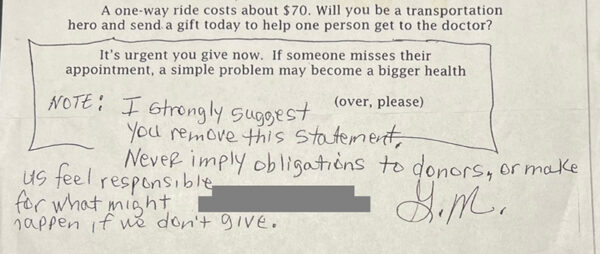There’s a difference between the messages most organizations want to send, and the messages that make donors want to give.
This is a Big Idea for organizations who want to grow their fundraising programs. Let me explain…
Most organizations have a way they like to talk about their organization and their work. They create this “way of talking about the organization” by having staff and core stakeholders come together and talk about why they think the organization is so effective and why its work is meaningful. And they talk about why they think people should give gifts.
Those ideas come together to form an organization’s messaging. And in some cases, those ideas are codified into a brand.
There are two important things to note here, and I believe they are the cause of most of the ineffective fundraising that’s out in the world.
First, note that the organization likes this messaging. Remember, the messaging is made up of the reasons staff and stakeholders think the organization is effective & meaningful. The “reasons for support” are the reasons those staff and stakeholders believe are the most important. The organization is sharing the reasons the staff and stakeholders think the donor should give a gift.
Second, most individual donors are markedly different from staff and stakeholders. The vast majority of individual donors – especially if an organization wants to scale past a few hundred donors – know less and care about different things than staff and stakeholders do.
Here’s a thought exercise for you…
If an organization sends out fundraising with messages that would motivate staff and stakeholders to give… but the people who receive the messages know less and care about different things than the staff and stakeholders… how well do you think the fundraising is going to work?
Not very.
The Leap
What happens for organizations that make “the leap” to the next level of fundraising success is that they start making their fundraising more other-centered.
The organization sets aside what staff and stakeholders like about their organization. They set aside why staff and stakeholders think people should support them.
The organization then does the hard work to figure out what donors tend to support. The organization does the hard work to figure out the messaging that causes regular people to respond.
So, are your appeals sending the messages your organization likes sharing? Or, are you sending or the messages that you’ve figured out are more likely to get a response? Because the messages an organization wants to send aren’t likely to be the messages that are most effective at causing individual donors to give.
***
If you’d like help creating and sending fundraising messages so that your organization makes “the leap” to your next level, get in touch. We stop taking new customers around the end of October because there’s so much to do for year-end, so if you’re interested, I’d encourage you to fill out this form for a free conversation.











